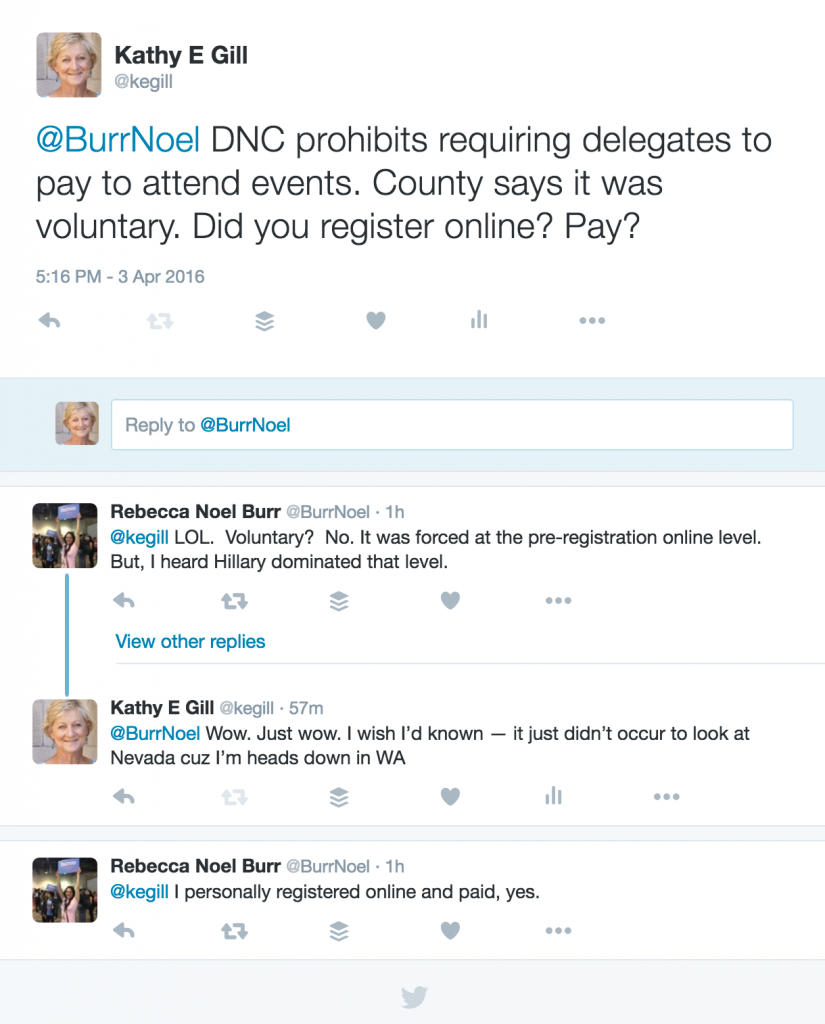Bernie Sanders scored a “surprise victory” over Hillary Clinton in Nevada on Saturday, taking 55% of the state delegates allocated on Saturday. With this win, at the June state convention the Sanders campaign has seats for 2,124 delegates and the Clinton campaign, 1,722.
Saturday marked stage two in Nevada’s Democratic Party caucus system, with precinct delegates attending county conventions.
The surprise came from the difference in this vote and the precinct-level vote. In February, Clinton won, 53-47%.
1. What does it mean “to win” at a county convention?
On Saturday, more delegates at the county conventions picked Sanders than picked Clinton.
When they were selected to attend the county convention at the February precinct caucus, each delegate was associated with a candidate. People supporting Clinton elected their delegates; people supporting Sanders did the same.
When they registered for Saturday’s conventions, these county convention delegates indicated their presidential preference. Ethically, they should have remained true to the candidate they said that they were supporting in February, otherwise they would disenfranchise the people who voted for them as a delegate. However, these are non-binding affiliations.
2. What happened on Saturday?
“News” reports like this one from the Washington Post are misleading and imply that the Sanders campaign did something nefarious:
Sanders’s supporters flooded the largest of those, in Clark County, where Las Vegas is located. As a result of his organizational muscle and some complicated rules, the senator from Vermont managed to garner more support there than Clinton, despite her edge on Feb. 20.
1. The rules aren’t complicated: if you ran as a delegate in February, you were pledging to your neighbors that you’d attend the county convention and represent them there.
Clark County voters elected about 9,000 delegates in February. Less than 4,000 showed up in April.
2. “Muscle” implies that the Sanders campaign did something nefarious, relative to the Clinton campaign. “Muscle” is slang used to describe the mafia.
Both campaigns had fewer delegates and alternates show up for the Clark County Convention than were elected in February.
More Sanders delegates showed up than Clinton delegates.
Was this because the “campaign” was better organized? If so, it was a grassroots effort. Because once the initial caucus is over, the official campaign presence in-state shrinks. At least that’s been the case in Washington.
Was it because Sanders supporters are more passionate than Clinton ones? Maybe.
The Clark County vote on Saturday
Regardless of the “why”, this is the “what”.
In February, 55% of the people who caucused in Clark County picked Clinton; 45% picked Sanders. Clark County accounts for more than two-thirds of the state delegates.
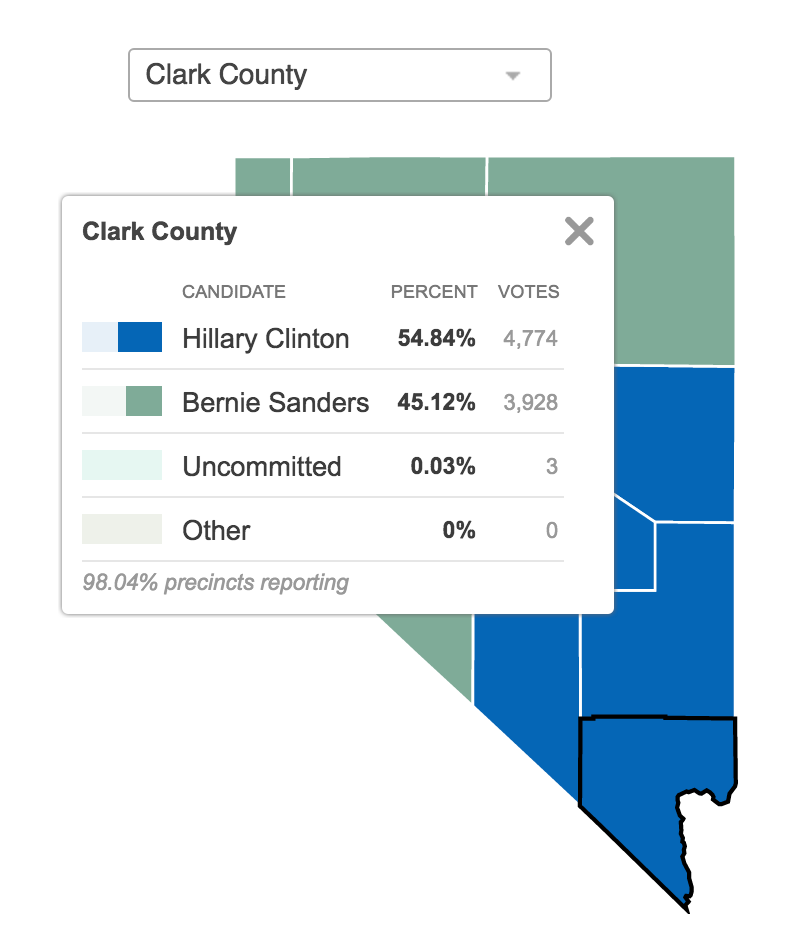
In April, the precinct-selected delegates who attended the Clark County (Las Vegas) Convention went 55-45% for Sanders, a result mirrored across the state. That means the Sanders campaign walked away with 1,613 state convention delegates compared to the Clinton campaign’s 1,298.
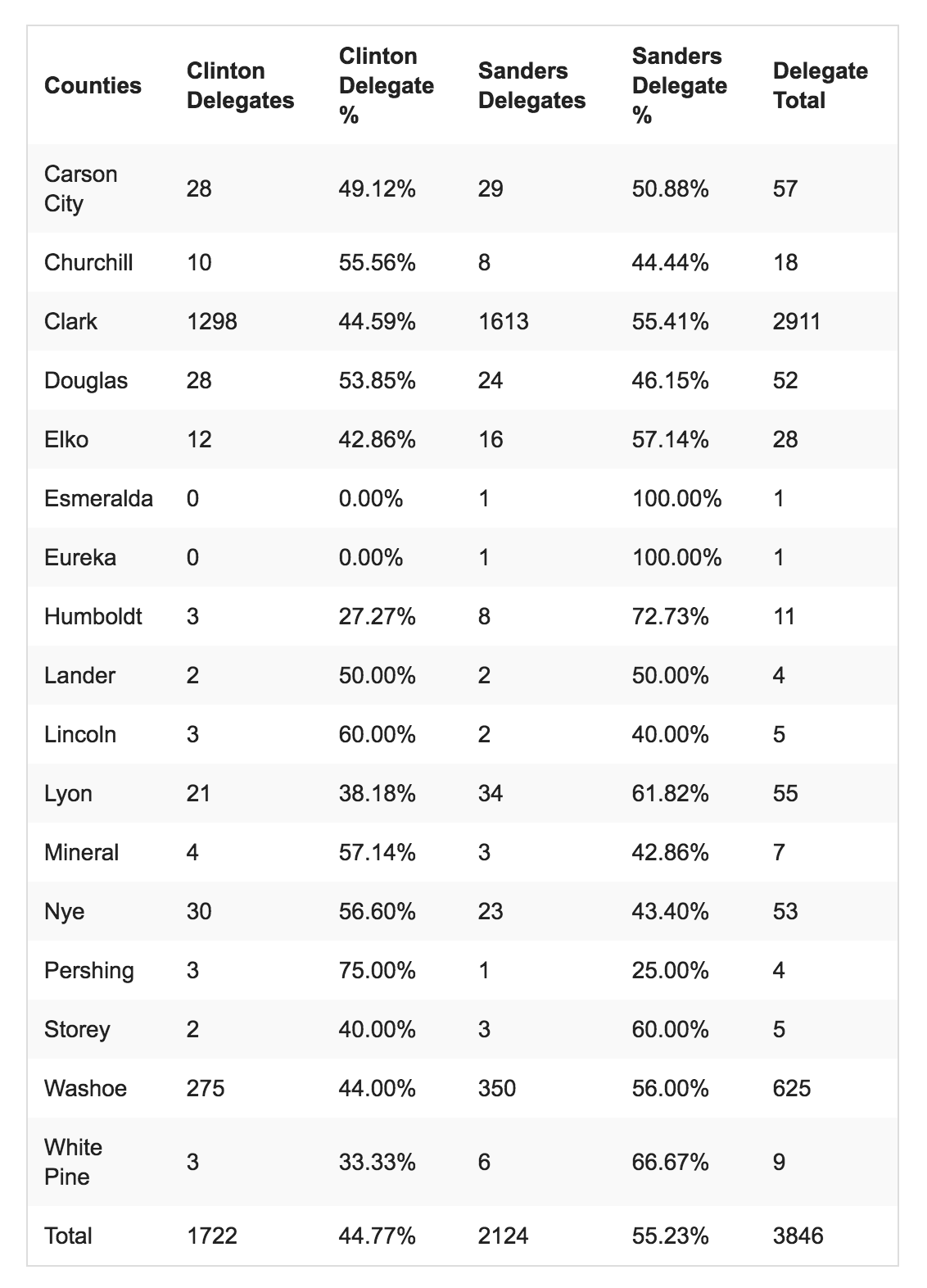
Delegates pledge to attend the next meeting; otherwise, why would anyone vote for them?
So what else might have caused a drop-off?
Arm-twisting in February? Maybe. A change of heart since February? Maybe.
Getting sick, unexpected need to work, sudden disinterest, family emergency, called out of town? All possible.
Another possible reason for the drop-off: because the Eventbrite registration asked for money (which is prohibited by DNC rules)?
Others raised concerns about the cost of the attending the convention — $26.62 through Eventbrite online — saying it is prohibitive for attendees. Officials say the amount is a voluntary contribution as convention costs are paid for by the county party. However, the party has said it will ask the campaigns for help covering the costs for supporters who attended but were unable to pay.
Rebecca Noel Burr, a Las Vegas attorney, told me that if you pre-registered for the Clark County Convention online you had to pay, unless you had a code to waive the fee.
I’m putting money on this as a contributing factor to the low turnout, although I don’t know if percentage drop-off was “normal”.
But this is why there are alternates. When a precinct delegate doesn’t show up, the alternate takes that slot so that the “vote” isn’t lost. Nevada has two types of alternates, those associated with a campaign and those who are not. But neither group was sufficient in numbers to counter the thousands of no-show delegates.
The urge to blame runs deep
Comments like these tweets are based on false assumptions.
A campaign cannot force delegates to attend the next step in a tiered selection process. Nor can a campaign prevent delegates from attending.
@KaivanShroff This was Sanders at his worst today. This undemocratic grab to steal a Nevada delegate or two will be his downfall.
— Jeff Gauvin (@JeffersonObama) April 3, 2016
Wanna be mad? Be angry at the Clinton delegates picked in February who chose to sit out the April conventions. Or who showed up but changed their vote. (No evidence that this happened, but it’s “legal” under Nevada’s non-binding preference rules.)
Be angry at the party for implying that you had to pay-to-play.
Despite this implementation, the system of delegate selection is democratic. But it is also representative. At each stage, fewer delegates are elected to advance. And representatives? They aren’t bound by voter polls. Just ask every member of Congress. Or your state legislature.
3. What happens at the state convention?
The state convention is where Saturday’s win will come into play.
Nevada will use a proportional representation system based on the results of the caucus-to-convention for apportioning delegates to the 2016 Democratic National Convention.
Nevada Delegate Selection Plan For the 2016 Democratic National Convention
There are four types of delegates:
- Congressional District allocated delegates
- At-large delegates
- Pledged party leader and elected officials (PLEO)
- Unpledged party leader and elected officials (PLEO, aka super delegates)
To be counted, delegates selected at the county conventions have to actually attend the state convention and stand for their candidate. The Sanders campaign has seats for 2,124 delegates and the Clinton campaign, 1,722. Only the non-pledged delegates (super-delegates) are exempt from that final vote.
Will everyone attend? If there is drop-off, will it be proportional?
Both the February and April events were non-binding presidential preference caucuses. Delegates selected in April can change allegiance before the June vote.
At the June 4th state convention, on the other hand, the vote is a binding presidential preference. The state convention as a whole — those delegates selected at County Conventions on Saturday — will elect the five (5) PLEO delegates as well as eight (8) at-large delegates and one (1) at-large alternate. District-level delegates and alternates will be elected by Congressional District Caucuses.
The final delegate allocation is 31 pledged delegates, three (3) pledged alternates, and eight (8) unpledged delegates, per the DNC delegate allocation document.
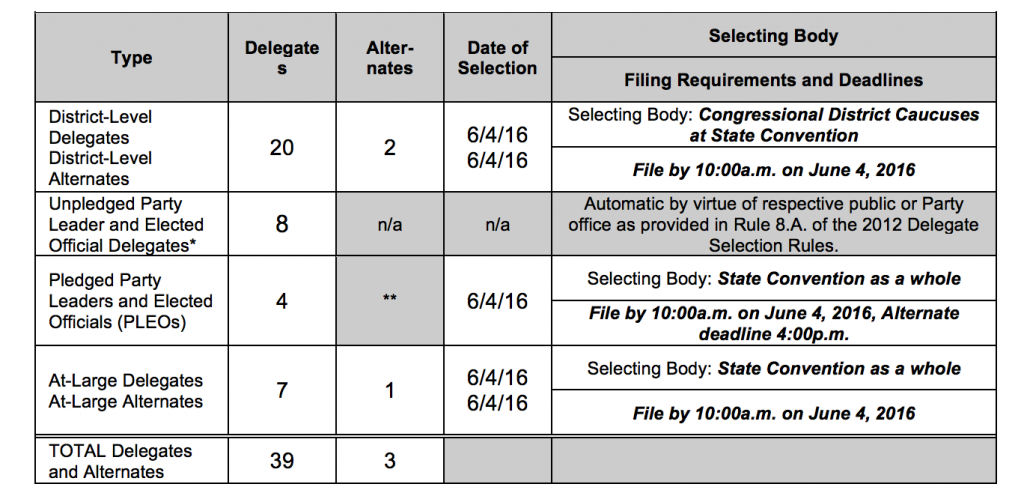
Only after the state convention will a headline saying “Sanders won Nevada” or “Clinton won Nevada” be truthful.
4. What about February’s caucus?
The February precinct-level caucuses determined the allocation of delegates to the county conventions.
According to the Las Vegas Sun, the state’s congressional district delegate allocation was determined at the February caucus. That means that 20 delegates and two (2) alternates will be allocated based on Clinton’s 53%-47% victory. [Note: the official delegate allocation document does not address this.]
The allocation of at-large delegates and pledged PLEOs, however, will be determined at the state convention.
The Nevada caucus selection process has three steps: precinct votes (February), the county convention (April), and the state convention (May). Horse race reporting doesn’t jibe with caucus nominations.
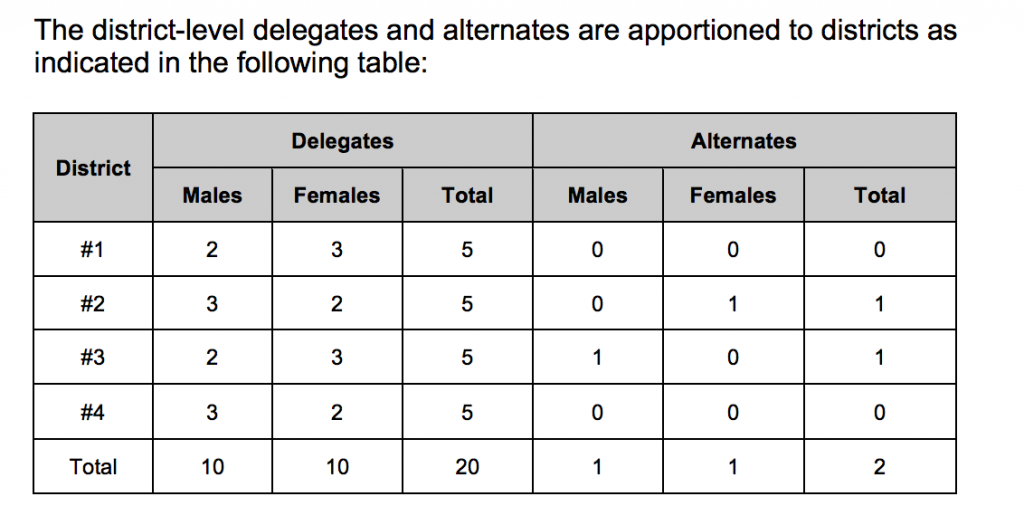
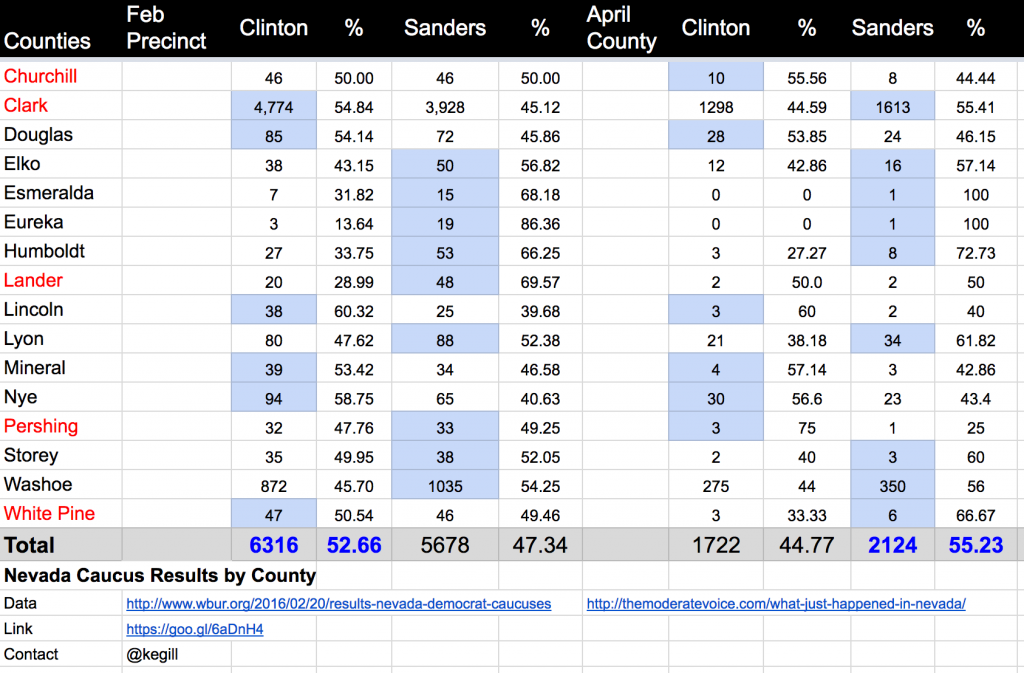
Edited Sunday, 12:30 pm // 1:30 pm // 2:30 pm Pacific
Eventbrite information added, 4:15 pm Pacific
Eventbrite information updated, 6:35 pm Pacific
Feb-April comparison information added, 6:35 pm Pacific
Clarification on possible Eventbrite impact, April 4
:: Follow me on Twitter
Featured image from 20 March 2016, Seattle rally, by @kegill
Known for gnawing at complex questions like a terrier with a bone. Digital evangelist, writer, teacher. Transplanted Southerner; teach newbies to ride motorcycles. @kegill (Twitter and Mastodon.social); wiredpen.com

















